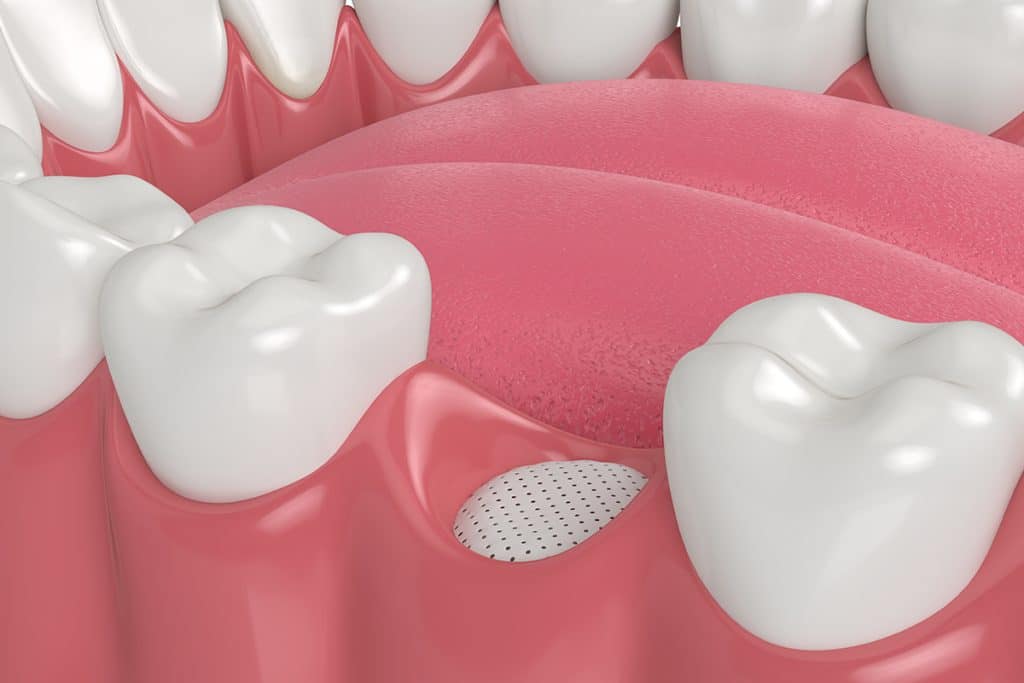How is Dental Bone Grafting Done?

Bone grafting is a procedure used to replace lost bone tissue. Bone augmentation procedures are used in a wide variety of medical fields, including dentistry. The process typically involves placing fragments of bone in a strategic location in order to supplement the existing bone.
In dentistry, bone grafting provides a solution to help replace lost bone tissue in the jaw. It is often used to assist dental implant placement. How is dental bone grafting done? Here’s an overview of the procedure.
What is Dental Bone Grafting?
In dentistry, a bone grafting procedure involves placing bone particles under the gum tissue on top of the existing jaw bone or inside a freshly extracted tooth socket. Grafting may include just one empty socket or span across a larger portion of the jaw. The gum tissue is sutured back in place over the freshly placed bone, covered with a collagen membrane, and the healing process begins. The bone graft incorporates with the existing bone, behaving as a scaffolding that encourages regeneration of the natural bone tissue to proliferate and increase bone volume.
Why is Bone Grafting Necessary in Dentistry?
Bone resorption in the jaw is a natural occurrence when teeth are missing. In the absence of a tooth and root, the support structures for that tooth are no longer physiologically stimulated. The jaw bone then atrophies over time, meaning it shortens and narrows, eventually losing volume.
As a result of bone atrophy, if you desire to replace one or more teeth with dental implants, the bone may be too thin to support them. Dental implants are artificial tooth roots that are surgically placed in the jaw bone to support a dental prosthetic. Bone grafting is often the bridge procedure that makes dental implants possible.
Where Does a Dental Bone Graft Come From?
The bone fragment used in a dental bone graft can come from a variety of sources:
- The patient’s body. Bone can be harvested from another bone in the patient’s own body. This type of graft, known as an “autologous graft” offers the greatest chance of compatibility, but it is the most invasive option and requires two surgical sites.
- Animal bone. A piece of bone may be taken from a cow or pig and sterilized in a lab before it is used in bone graft procedure. Animal Bone or “Xenograft” takes the longest to incorporate into the body.
- A cadaver. Cadaver bone or “Allograft” is a most often utilized bone graft because human bone is highly compatible with other human bone.
- Artificial bone. Synthetic bone fragments are created in a lab that closely resemble natural tooth material and provide the same results in most cases.
Who Performs Bone Grafting Procedures?
Bone grafting is most often performed by an oral surgeon. An oral surgeon is a dental specialist who focuses specifically on surgical procedures that require cutting into tissue. A bone graft is a minimally invasive oral surgery, but it is considered to be surgical.
Types of Bone Graft Procedures
There are a few different types of bone grafting procedures used in dentistry:
- Major and minor bone grafting. These procedures are used when the bone loss in the jaw is significant enough that there is insufficient bone structure to support a dental implant.
- Socket preservation. Socket preservation is done proactively to prevent bone loss in the jaw after extracting a tooth. Natural or artificial bone tissue is placed in the socket immediately after the extraction.
- Ridge augmentation. Ridge augmentation can be done later, after a tooth is extracted or has been missing. Bone tissue is used to strengthen or rebuild the alveolar ridge, which is the dental term for the jaw bone that supports a tooth when it is in the socket. This type of grafting is difficult and can be less predictable than socket grafting.
- Sinus lift. When a dental implant needs to be placed in the upper jaw, it is important that the bone is thick enough to prevent the implant from being unsupported inside the sinus cavity. If there is not sufficient bone density, a sinus lift procedure can be done to thicken the bone in preparation for an upper dental implant.
Who Should I See For Bone Grafting?
If you’re looking for an oral surgeon in Boston who can provide bone grafting, come to Lucca Oral and Facial Surgery. We specialize in bone grafting procedures and other dental surgeries with a complete range of anesthesia and sedation options available. We always take the most minimally invasive approach possible for your comfort and faster recovery.
To learn more, call 617-300-0345 or contact us today to schedule an appointment.






